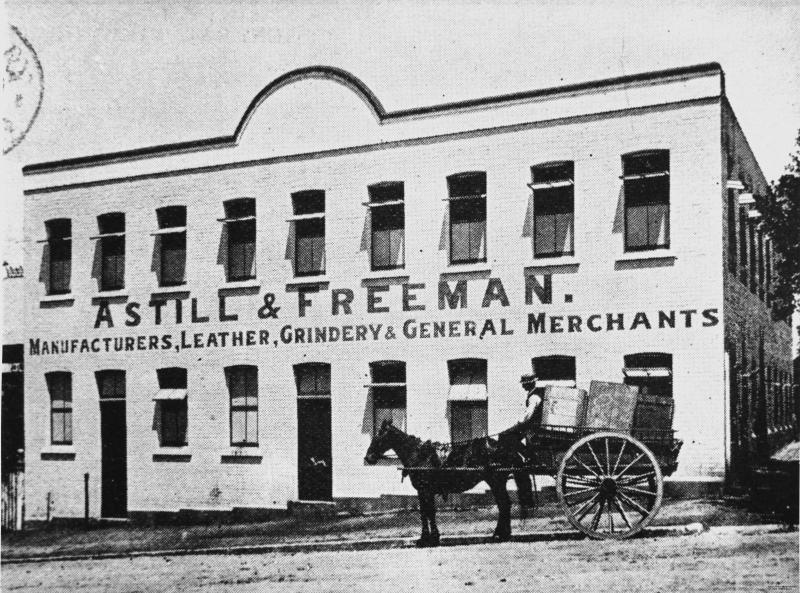Addresses
Type of place
Factory
Period
Federation 1890-1914
Style
Warehouse
Addresses
Type of place
Factory
Period
Federation 1890-1914
Style
Warehouse
The Astill and Freeman Boot Factory was constructed circa 1897 for owners Joseph Astill and James Henry Freeman. Boot making was an important industry in the nineteenth and early twentieth centuries and by 1897 there were at least 18 small boot factories throughout Queensland. This factory was one of the places where mechanisation was first introduced into Brisbane industry and was the site of a significant industrial dispute between the owners and the Bootmaker’s Union over working conditions. After operating as a boot-making factory for more than 60 years under a number of different names and owners, the building was sold in 1964 to Batchelor and Jolly Pty Ltd, a leather manufacturing company who operated their business from the building until 1994.
Also known as
Astill and Freeman Boot Factory
Lot plan
L137_B3137
Key dates
Local Heritage Place Since —
Date of Citation —
Construction
Walls: Brick - PaintedCriterion for listing
(A) Historical; (D) RepresentativeInteractive mapping
Also known as
Astill and Freeman Boot Factory
Lot plan
L137_B3137
Key dates
Local Heritage Place Since —
Date of Citation —
Construction
Walls: Brick - PaintedCriterion for listing
(A) Historical; (D) RepresentativeInteractive mapping
History
This former boot factory was constructed soon after Joseph Astill and James Henry Freeman acquired the thirty-six perch site in November 1895. Astill and Freeman were operating as bootmakers in Tank Street, Brisbane at the time they purchased the land. They moved to Mary Street, Brisbane during 1896 and are recorded in the Cordelia Street property in 1897. The partners took out a £600 secured loan to the Commercial Banking Company of Sydney Limited in November 1896, which may have gone towards the erection of these premises.
In 1888 Queensland imported £179,000 worth of boots and shoes, and at that time there were more than 140 other boot making establishments in Brisbane, although many of these were individual bootmakers working from their own house or small workshop. In 1888 there were 18 small boot factories throughout Queensland; in 1897 that number had increased to 39, employing 1 546 people. Competition in the boot making industry was fierce. During the 1890s clothing and textile manufacturers formed the largest group within Brisbane's manufacturing sector, employing over 40 per cent of the industrial workforce. The boot trade represented a large sub-group within this division, employing 29 per cent of the clothing and textile workforce.
Mechanisation occurred in several Brisbane industries during the 1890s. It was most extensive in the boot trade, where its introduction was expedited by the 1895 bootmakers strike. Unionists had complained of poor conditions in boot factories for several years. Employers refused to meet union demands, resulting in a series of unsuccessful strikes. This culminated in a 14-week strike from May to August 1895 involving 400 men and virtually bringing the whole industry in Brisbane to a standstill. The workers' efforts were wasted however, and starvation eventually forced the men to return to work on management's conditions, which included a reduction in wages. When the mechanisation of the industry followed soon after, many men lost their jobs. Boys were employed in large numbers, and teamwork, involving specialisation of labour was introduced.
By 1897, when this factory was established in South Brisbane, those still working for wages were receiving up to 35 per cent below the reduced rate agreed upon after the 1895 strike. At the same time only £51,097 worth of boots and shoes were imported, a reduction in nine years of £128,000, brought about largely by the increase in domestic manufacture.
After the death of James Freeman in 1893, Arthur Freeman took his place in the company, and the business continued to trade under its original name. An additional mortgage was taken out in 1900 for £810, but the death of Arthur Freeman in 1909 brought the partnership to an eventual end. By 1911 a new firm of Astill and Simpson Limited controlled the business, but this was shortlived and in 1914 title reverted to Joseph Astill & Co Limited. Trade continued under this name until 1944 when the company became known as J & R Astill (Pty) Ltd. In 1964 the business was sold to Jolly and Batchelor Pty Limited, a leather manufacturing company. The premise continued to operate as part of the leather goods manufacturing industry until its sale in 1994. Although now used for other purposes, the structure’s exposed brickwork, internal posts and beams remain as a reminder of the significance of this industry.
Description
This two-storey brick factory demonstrates its function as a light industrial building of the 1890s in its simple elevation and lack of decorative detail. The large windows have low curved arch brick lintels and provide light and ventilation to the factory floor. The external facades feature bonded brick walls with a low parapet to the front and sides. Finished with a simple brick cornice, the parapet conceals a double-hipped metal roof with box gutter running front to back between the two roofs. Internal floors are of timber construction with herringbone strutting.
Statement of significance
Relevant assessment criteria
This is a place of local heritage significance and meets one or more of the local heritage criteria under the Heritage planning scheme policy of the Brisbane City Plan 2014. It is significant because:
Supporting images

The Queenslander (Brisbane, Qld. : 1866-1939),
‘Astill & Freeman's leather factory, South Brisbane, 1900',
John Oxley Library, State Library of Queensland.

Photographer unknown,
‘Warehouse - South Brisbane’, 22 June 1961,
Brisbane City Council Library Services, Brisbane City Council.
Citation prepared by — Brisbane City Council (page revised September 2020)